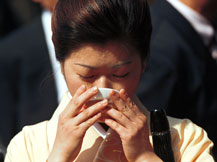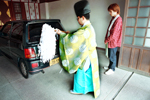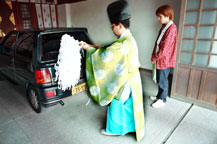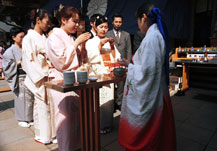Covering
Japan: Nagasaki Journal |
The Students
The Classes
Place
for Prayer
Shrine Visits Are a Part of Routine for Nagasaki Residents
By Bruce Gerstman
Special to the Mercury News
(This story originally appeared in the San Jose Mercury
News on August 8, 2002. Click here
to view it on the Mercury News web site)
NAGASAKI, Japan – Standing in the
Suwa Shrine's garage, with hanging lanterns reflected in the white Toyota's
shiny chrome, the husband and wife bowed their heads and prayed. In front
of them, a Shinto priest chanted and waved a wand with strands of white
paper dangling from the end.
Please, gods, keep this car and its owners out of accidents and ensure
their safe driving.
|
The ceremony lasted about 15 minutes.
The grateful couple thanked the priest, who wore a cone of black fabric
on his head, for blessing their new car. Then, the husband ran out to
answer his cell phone.
"People wish for safe driving,'' said Norio Niina, the shrine's assistant
priest. "Japanese people don't like dented cars, unlike Americans,''
he said, grinning.
Getting one's car blessed is a typical ritual at this 377-year-old shrine,
but only one of many rituals every day. People come in work suits and
sweatshirts, ceremonial robes and kimonos. They make ordinary wishes to
stay healthy or get a promotion. Babies are blessed and weddings sanctified.
Students write notes on small blocks of wood called emma, or "horse-drawing,''
asking the spirits for good grades on their exams. To quit smoking or
end a love affair, some adults tie string around the statue of a lion,
a symbol of restraint. Others pray for world peace.
This habitual prayer is as much a routine here and at Shinto shrines around
Japan as grabbing a bowl of noodles for lunch, or picking up groceries
after work. Of the roughly 50 shrines around town, Suwa is considered
by locals to be Nagasaki's main shrine because it is the largest and one
of the oldest in the city. They also say it has the most parking.
Suwa is a complex of dark wooden buildings, tucked among trees and balanced
on a slope. To reach the shrine, it's a steep climb of about 200 stone
steps up the mountain, under knots of tangled telephone wires and vending
machines selling Coke, teas and coffees that lean against apartment buildings.
The shrine's open beams face a courtyard. The roofs curl up at the corners.
At the edge of the grounds, a pathway that leads to smaller prayer structures
cuts through the woods. Most visitors stay outdoors to pray and seek blessings,
as mopeds speed by the foot of the hill.
Along with the emma, which cost $5 to $10 and are hung on a wall with
hundreds of other offerings, the priests of Suwa sell other spiritual
trinkets, often red or green cloth satchels about the size of a rabbit's
foot for health, prosperity or fertility. But they also sell good-luck
charms designed for the moment, like the yellow-and-red-striped token
with an image of bird clutching a soccer ball. This one was supposed to
help the Japanese team win the World Cup. A poster advertising the pendants
was stapled against a 130-year-old door.
|
"We sold less than expected,'' Niina,
the assistant priest, said, sitting on the floor with a cup of tea.
Some of the older structures have stood since Suwa's last major renovation
was completed in 1870 after a fire. At the end of World War II, the atomic
bomb that exploded beyond the hills a few miles away and killed about
75,000 people merely rocked the shrine off its foundation.
Suwa became a shrine in 1625, the creation of the military Tokugawa government.
It was a time when Nagasaki traded only with the Dutch and Chinese, because
the ruling shogun had closed the nation to the rest of the world. He also
had outlawed Catholicism, which Portuguese and Spanish missionaries brought
in the 1500s.
Today, Suwa attracts visitors regardless of their religion, although most
are Buddhists, said Teruhiko Oga, the shrine's head priest.
"When people walk away from Suwa Shrine, they go back to their own
religion,'' Oga said, sitting in a room that overlooked a creek.
Every October, the deities from Suwa come down to bless and purify the
city as part of the Kunchi Festival, which is well-known around Japan's
southern main island of Kyushu. Usually, about 100,000 people watch processions
of dragons and floats through the streets. Groups of men carry wooden
boxes that house the shrine's three deities: one that fights against bad
luck, another that looks after the creatures in the sea and sailors, and
a third that ensures happy marriages and safe childbirth. Then the gods
sit near the harbor for three days.
Oga, the head priest, said that those who show up at Suwa from time to
time do so because they work hard but know they cannot succeed without
extra help. They come to ask the deities for what they cannot do themselves.
In return, he said, they get a sense of relief and "a satisfaction
of mind.''
 |
That is why Tetsko Takamure stopped here with her 9-month-old son. Pausing in front of the main shinden, or "god-house,'' she bowed and clapped twice. Then, she balanced her son on top of a box where visitors drop donations, held his hands and clapped them together.
The 35-year-old Takamure said she prayed
for two things: her husband's safety as he drives around as a traveling
salesman, and her baby's health. She said she lives in the neighborhood
and drops by throughout the week on her afternoon stroll before dinner.
"This is my usual route,'' she said, as her baby laughed and grabbed
her T-shirt. A few minutes later, she was gone.
Others arrive on a regular schedule. Yaeko Inoue said she had come to
pray on the first day of every month since she was 25. She paused a moment
to think about that. She then smiled and said it's been about 45 years.
"I don't know why, but I feel relieved when I pray. I usually pray
for health,'' she said, dabbing the sweat from her face into a neatly
folded kerchief in one hand, and holding a cloth sun umbrella in the other.



